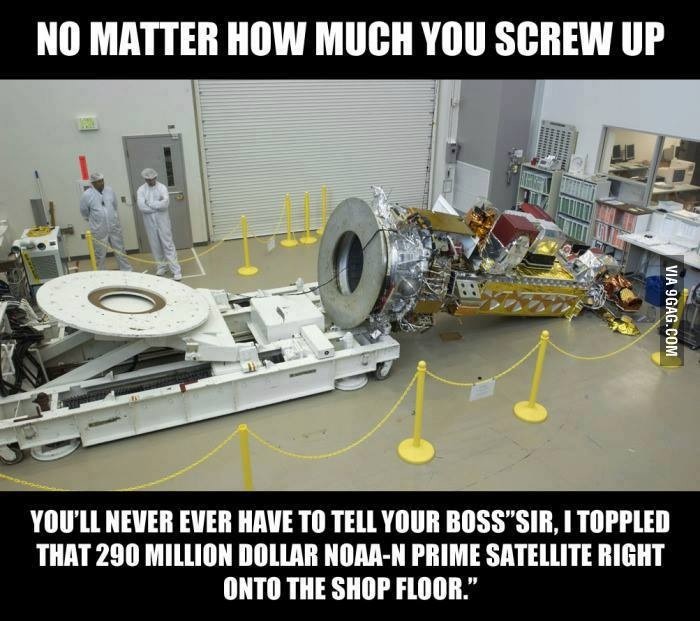Recently, Donald.McLean posted this image in The Pod Bay, the site chat room:

It's a rather disturbing image once you think about it for more than about half a second. Did it really happen? What consequences is it going to have for the mission?
Recently, Donald.McLean posted this image in The Pod Bay, the site chat room:

It's a rather disturbing image once you think about it for more than about half a second. Did it really happen? What consequences is it going to have for the mission?
Yes, it really happened.
It took place at the Lockheed Martin Space Systems factory in Sunnyvale, California. As the team was turning the satellite into a horizontal position, they found out that the twenty-four bolts that were supposed to hold it in place had been removed by a technician - and the action was never documented.
The NASA Mishap Board investigating damage to the NOAA-N-Prime satellite has released its final report.
On September 6, 2003, the National Oceanic and Atmospheric Administration (NOAA) N-Prime satellite fell to the Lockheed Martin Space Systems Company factory floor in Sunnyvale, Calif. Technicians were working on the spacecraft, when the accident happened. The spacecraft suffered significant damage.
The Board, chaired by the NASA Deputy Associate Administrator of the Science Mission Directorate, had representatives from NASA research centers and the Air Force Space Command, as well as advisors from NOAA and the Federal Aviation Administration.
The full report is here.
From "Final Launch in NOAA Series" in Aviation Week & Space Technology, 26 January 09:
After it suffered significant damage when it tipped over on the factory floor in September 2003, the contractor used fees earned on the NOAA spacecraft it previously built to cover the cost of repairs.
Fortunately, since NOAA-N Prime was the last in the series, there were backup instruments and components available, so the contractor required “only a few” new components to fill in gaps, said NASA’s Wayne McIntyre, program manager for the Polar-orbiting Environmental Satellite, during a briefing on Jan. 22.
The satellite was launched in February 2009.
The story behind this is one of several layers of procedures, as is documented in a review of NASA "mishaps". Essentially, the story comes down to the following sequence of events:
In addition, there were numerous steps that were not followed, such as not having a safety person in attendance for a potentially hazardous test. In fact, they came up with several suggested tips for anyone in this situation in said report. Here's the highlights
- Communicate all changes on the floor to all technicians and supervisors.
- Is this really working in your program now?
- Do not back stamp procedures
- Are your technicians doing this now? This has been a factor in many mishaps!
- If an audit or an investigation identifies a problem, or a non-conformance, fix it! – This has been a factor in previous mishaps
This satellite, NOAA-19 or NOAA-N Prime was launched in February 2009. The pictured incident happened in 2003:
The spacecraft has had a troubled history at Lockheed Martin’s Sunnyvale, Calif., factory. After it suffered significant damage when it tipped over on the factory floor in September 2003, the contractor used fees earned on the NOAA spacecraft it previously built to cover the cost of repairs.
Fortunately, since NOAA-N Prime was the last in the series, there were backup instruments and components available, so the contractor required “only a few” new components to fill in gaps, said NASA’s Wayne McIntyre, program manager for the Polar-orbiting Environmental Satellite, during a briefing on Jan. 22.
From "Final Launch in NOAA Series" in Aviation Week & Space Technology, 26 January 09